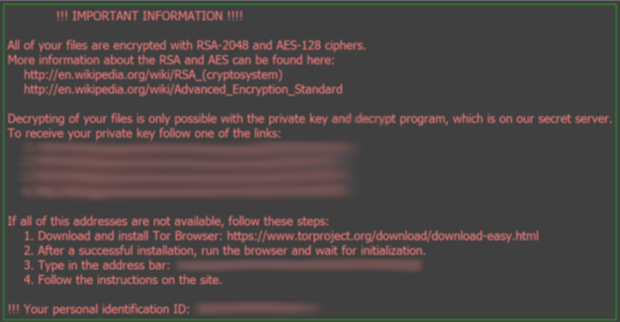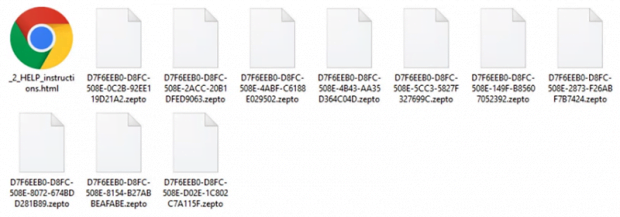Decrypt .zepto file virus: Zepto ransomware removal and decryption guide

The cybercrooks liable for distributing Locky, one of the dominating ransomware scourges of the current year, appear to have started a new campaign with a couple of tangible differences made to their extortion tactic. The new successor dubbed the Bart ransomware is on the loose, operating concurrently with the new iteration of Locky proper. Bart is adding its victims’ valuable files to ZIP archives that cannot be opened unless the user has the right password to unlock the archive. The revamped edition of the notorious Trojan, in its turn, is appending the .zepto extension to the scrambled objects.
This reincarnation of Locky contaminates Windows computers through spam the carries a contagious loader, which is in fact an obfuscated JavaScript entity. Obviously, its authors have switched to a different botnet after their previous campaign had come to a decline a few months ago. The compromise workflow is quite similar to what it looked like before: an unsuspecting user receives a catchy email that encourages him or her to open the harmful attachment. The execution of the ransomware is furtive enough for the victim to only notice the aftermath.
The offending program silently looks for personal files on the machine’s local drives, removable ones and mapped network paths. Once the list is ready, the Trojan leverages the AES-128 cipher to encrypt every file, and then applies the asymmetric RSA-2048 cryptosystem to encode the secret decryption key.
Having performed the complex data encryption manipulations, the malady makes filenames indiscernible and concatenates the .zepto extension to each. As a result, a random data item gets a name similar to D7F6EEBA-D9FC508E-0B2C-82EED365C05D.zepto. It also changes the Windows desktop image to _HELP_instructions.bmp and creates a new file named _HELP_instructions.html inside every encrypted folder as well as on the Desktop proper. These are ransom instructions that contain the victim’s personal identification ID, several Tor links to receive the private key, and the following warning message: “All of your files are encrypted with RSA-2048 and AES-128 ciphers”. The perpetrators go on to say “Decrypting of your files is only possible with the private key and decrypt program, which is on our secret server”.
When the victim follows one of the Tor gateways listed in the _HELP_instructions.html (.bmp) document, they end up on the “Locky Decryptor Page”. The page is tailored specifically for submitting payments to a unique Bitcoin address and downloading the decryptor. The ransom that the threat actors demand for recovery amounts to 0.5 Bitcoins, or approximately 300 USD. If a big enterprise network falls victim to this ransomware, the buyout will most likely presuppose a larger payment.
The comeback of the Locky ransomware is definitely bad news for the security industry and end users around the globe. The gang behind it proved to be ambitious enough to try and change the status quo on the extortion arena, so the attack surface is probably going to be huge. Whereas there is no viable fix that could restore the locked data at this point, some recovery techniques can be of help.
Table of Contents
Zepto files file automatic removal
Extermination of this ransomware can be efficiently accomplished with reliable security software. Sticking to the automatic cleanup technique ensures that all components of the infection get thoroughly wiped from your system.
1. Download recommended security utility and get your PC checked for malicious objects by selecting the Start Computer Scan option
Download Zepto files ransomware remover
2. The scan will come up with a list of detected items. Click Fix Threats to get the file and related infections removed from your system. Completing this phase of the cleanup process is most likely to lead to complete eradication of the plague proper. Now you are facing a bigger challenge – try and get your data back.
Methods to restore files encrypted by Zepto files file
Workaround 1: Use file recovery software
It’s important to know that the Zepto files file creates copies of your files and encrypts them. In the meanwhile, the original files get deleted. There are applications out there that can restore the removed data. You can utilize tools like Stellar Data Recovery for this purpose. The newest version of the file under consideration tends to apply secure deletion with several overwrites, but in any case this method is worth a try.
Download Stellar Data Recovery Professional
Workaround 2: Make use of backups
First and foremost, this is a great way of recovering your files. It’s only applicable, though, if you have been backing up the information stored on your machine. If so, do not fail to benefit from your forethought.
Workaround 3: Use Shadow Volume Copies
In case you didn’t know, the operating system creates so-called Shadow Volume Copies of every file as long as System Restore is activated on the computer. As restore points are created at specified intervals, snapshots of files as they appear at that moment are generated as well. Be advised this method does not ensure the recovery of the latest versions of your files. It’s certainly worth a shot though. This workflow is doable in two ways: manually and through the use of an automatic solution. Let’s first take a look at the manual process.
-
Use the Previous Versions feature
The Windows OS provides a built-in option of recovering previous versions of files. It can also be applied to folders. Just right-click on a file or folder, select Properties and hit the tab named Previous Versions. Within the versions area, you will see the list of backed up copies of the file / folder, with the respective time and date indication. Select the latest entry and click Copy if you wish to restore the object to a new location that you can specify. If you click the Restore button, the item will be restored to its original location.

-
Apply Shadow Explorer tool
This workflow allows restoring previous versions of files and folders in an automatic mode rather than by hand. To do this, download and install the Shadow Explorer application. After you run it, select the drive name and the date that the file versions were created. Right-click on the folder or file of interest and select the Export option. Then simply specify the location to which the data should be restored.

Verify whether Zepto files file has been completely removed
Again, ransomware removal alone does not lead to the decryption of your personal files. The data restore methods highlighted above may or may not do the trick, but the file itself does not belong inside your computer. Incidentally, it often comes with other file, which is why it definitely makes sense to repeatedly scan the system with automatic security software in order to make sure no harmful remnants of this file and associated threats are left inside Windows Registry and other locations.
Posted in: KnowledgeBase
Leave a Comment (0) ↓




